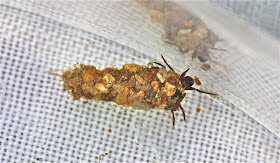Thursday, December 22, 2011
Where to Begin? A Stream Report on the Upper Doyles River
I suppose the obvious place to begin is with something new. The flatheaded mayfly, Epeorus Pleuralis.
This is the "two-tailed" flatheaded mayfly with the large, fan-shaped gills that act as "suction cups" helping them to hold on to the rocks in fast current. (And, yes, it is time to start looking under the rocks in addition to sifting through leaf packs!) In the streams inhabited by Epeorus pleuralis, -- e.g. the Doyles, Buck Mt. Creek, the Rapidan -- this is the flatheaded mayfly that will dominate samples into the spring. Tolerance value: 1.5.
I selected these two for my photos. There were a lot of them on the rocks: many were still very tiny.
But, there were two other flatheaded species around: Maccaffertum vicarium and Maccaffertium x (meaning I'm not sure of the species, but whatever it is, it's big!). The banding on the abdominal segments indicates M. vicarium right away, so too, do the reddish markings on the legs and the tails.
And here's the other Mac species: I'll work on the species ID when I have time.
I suspect the Epeorus flatheaded nymph would be the dominant taxon today if I had done a head count. But I also found a lot of Green stoneflies (Chloroperlids), and they're starting to show their true colors. In fact at this site, they're large enough now to confirm that the genus is indeed Sweltsa.
For the genus ID -- if we work through the key in Peckarsky (Freshwater Macroinvertebrates, p. 73), we come to a choice between:
48a. Inner margin of hind wingpads parallel to body axis; fewer than 6 short, coarse setae between compound eye and hind margin of head .... Haploperla
or
48b. Inner margin of hind wingpads angled away from body axis; more than 6 short, coarse setae between compound eye and hind margin of head .... go to 49.
The wingpads on the nymphs that I found this morning are big enough for us to see that they clearly "angle away from the body axis."
And, though they may be hard to see in this picture, there are certainly more than 6 coarse setae behind the compound eye.
So Haploperla is eliminated. So too is Rasvena, since the dorsum of the abdomen is monchromatic and does not have "4 longitudinal dark stripes" (Peckarsky, couplet 49a./49b.).
That brings us to the following choice.
50a. Thick, black, depressed hairs present laterally on all thoracic sterna ... Sweltsa
or
50b. Thick, black, depressed hairs absent from lateral thoracic sterna; sternal hairs erect, light-colored ...
Suwallia
Let's look at the chest.
These are Sweltsa Chloroperlids for sure. The tolerance value for Sweltsa species is 0.2: we find these only in very good streams.
Perlodid stoneflies were also common today. I found three different species: Clioperla clio, Diploperla duplicata, and a very small Isoperla namata. Photos in order.
Now, how on earth do we know that this last Perlodid is Isoperla namata?! The Isoperla ID can be established in the usual way with a microscope: look at the "Y" ridge and the shape and make-up of the lacinia. But how do we know that it's the species namata? It's the pattern that's taking shape on top of the head that gives that away. This is the same pattern we see on mature, much more colorful nymphs.
Compare the two heads.
I. namata is the most common Perlodid species we see in our area streams, and we'll be seeing a lot of them in March, April, and May.
Just three other things.
1) A beautiful, fairly mature, Giant stonefly. And as much as I want to work on species ID for the Giants, I couldn't bring myself to preserve this beauty so I could do the requisite microscope work.
2. I found more Uenoid caddisfly cases today adhering to rocks. And the colors of the cases I found in the upper Doyles River were quite different than those I found only Tuesday at Buck Mt. Creek. The larvae use the pebblies and sand that they have at hand.
3. And finally, I found a pupating caddis sealed away in its cocoon. This is probably a free-living caddis or a fingernet caddis -- but we can only be sure by taking the pupa out of its sack. In the ventral view, the pupa is quite visible inside its cocoon.
Dorsal view:
Ventral view:
______________
Oh. There was one other thing. I put the Clioperla nymph in a separate container this morning so it wouldn't eat the other insects for breakfast. Unfortunately, when I put it into a petri dish for taking its photo, I left a Green stonefly nymph and a Small winter nymph in the tray with it. And that was the end of the Small winter stonefly!


















No comments:
Post a Comment